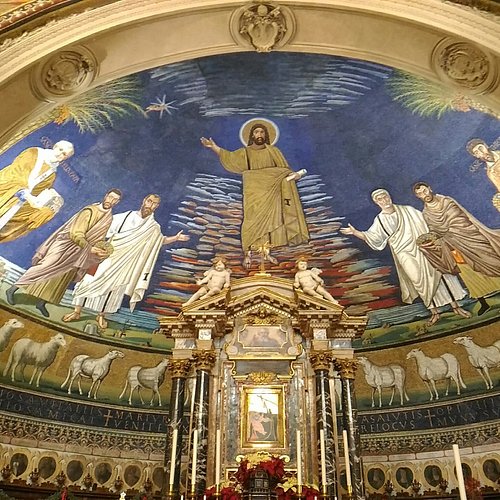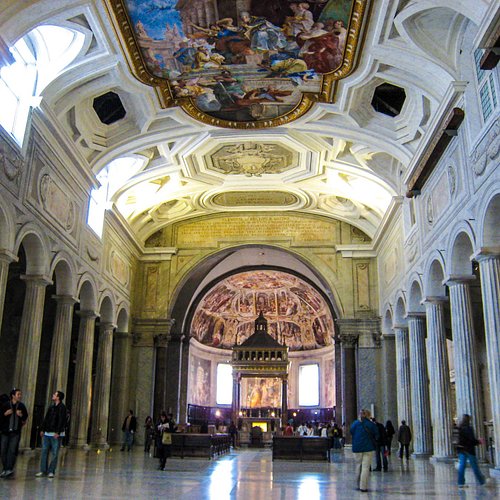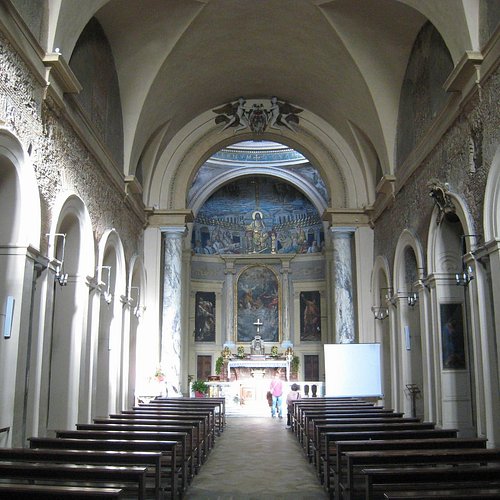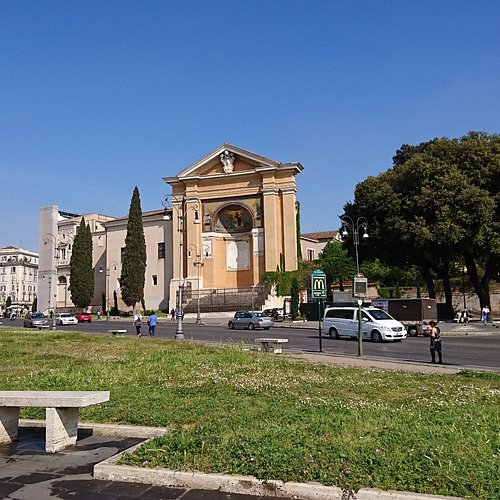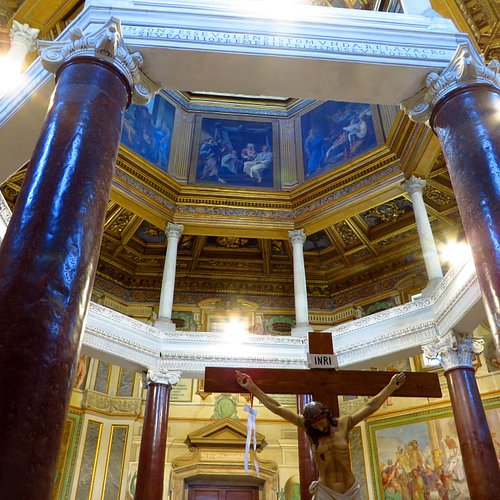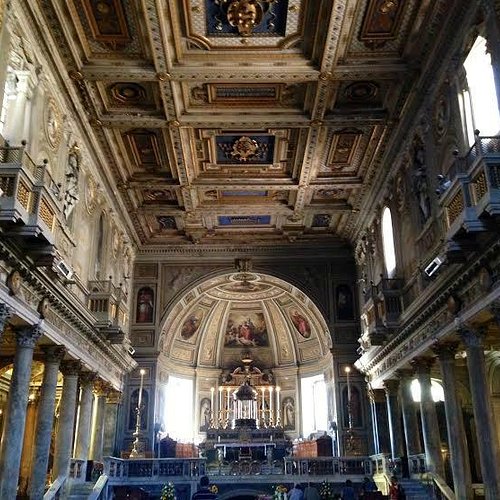The 10 Best Churches & Cathedrals in Monti, Lazio
Rome wasn't built in a day--and you'll need much more than a day to take in this timeless city. The city is a real-life collage of piazzas, open-air markets, and astonishing historic sites. Toss a coin into the Trevi Fountain, contemplate the Colosseum and the Pantheon, and sample a perfect espresso or gelato before spending an afternoon shopping at the Campo de’Fiori or Via Veneto. Enjoy some of the most memorable meals of your life here, too, from fresh pasta to succulent fried artichokes or a tender oxtail stew.
Restaurants in Rome
1. Cappella di San Lorenzo in Palatio
Overall Ratings
5.0 based on 2 reviews
Reviewed By dapper777 - Monaco, null
You have to climb the flanking staircases of the Holy Stairs to reach the Sancta Sanctorum, or what was once the chapel reserved for the popes in the ancient Patriarchy, the papal palace, built in the fourth century and used throughout the thirteenth century in the Lateran. In the old days, the papal palace was a grandiose building, and incorporated also the precious chapel built on the remains of an oratory dedicated to St. Lawrence, the "Oratorium Sancti Laurentii de Palatio". However, this medieval papal palace was demolished at the end of the 16th century by pope Sixtus V and then rebuilt in its present form by the architect Domenico Fontana. Outside the building, an apse decorated with mosaics represents what remains of the Leonian Triclinium, the dining room of Pope Leo III from the end of the eighth century, demolished in 1733 and partially rebuilt by Ferdinando Fuga. Everything was demolished and destroyed, but Sixtus V decided to save the Sancta Sanctorum, by incorporating it into the Scala Santa building, which he himself had built around the medieval chapel. Within the medieval patriarchy, the chapel was an exclusive place, intended only for a privileged few. Located in the private wing of the papal residence, the chapel housed some very venerated relics, and for this reason defined the "Holies of Holies", the sancta sanctorum, precisely. Among the numerous relics once preserved in this place, the image of the Redeemer Acheropita ('that is not painted by human hand'), which is still present above the altar (it is dated to the mid 5th century), two fragments of the cross of Jesus, his sandals, the foreskin of the Child Jesus and the tools of his passion. Many of these relics are now preserved elsewhere. The altar has a railing grid, evoking the gridiron of St. Lawrence, which protect the original wooden relic-chest installed here at the beginning of the 9th century. Above the altar is the inscription "Non est in toto sanctior orbe locus" (There is no holier place in the world than this). It is located in the Scala Santa complex, at the end of the stairs on the walls of which are frescoes depicting Stories from the Old Testament and Stories of Christ by various painters, including Giovanni Baglione, Paolo Brill and Paris Nogari. It is also called Sancta Sanctorum, because it recalls the name given to the Jews to the part of the temple in Jerusalem where the Holy Ark was kept, and which was so named because the most precious Christian relics were kept in it. Its construction dates back to the thirteenth century, it was restored by Pope Honorius III and rebuilt by Pope Nicholas III. The transfer of the Scala Santa would have taken place, however, in the years of the pontificate of Sixtus V, therefore in the sixteenth century. The frescoes that can be seen inside the chapel date back to the 13th century. The four Evangelists are depicted, Pope Nicholas III, the martyrdom of St. Peter and St. Paul, the "Beheading of St. Agnes" and the "Stoning-to-death of St. Stephen". The so-called "Loggia dei Santi" was, on the other hand, built by the painters Cesare Nebbia and Giovanni Guerra. The Sancta Sanctorum retains the appearance of the 1278 reconstruction by the Cosmati, with the sole exception of the figures of the saints in the little niches added in the early sixteenth century. The frescoes on the vault (the four Evangelists) and in the lunettes are splendid. The ceiling is barrel-vaulted. In the center is the Christ the King ( Pantocrator) in a large tondo supported by 4 angels. The frescoes on the vault and in the lunettes are from the 13th century, while the saints within the pointed aedicules are by Giannicola di Paola. The paintings depicting the Stations of the Cross are also noteworthy. This chapel is a rare and priceless jewel. It deserves to be visited.
2. Basilica dei Santi Cosma e Damiano
Overall Ratings
4.5 based on 172 reviews
Located on the fringe of the Forum, this small church incorporates the pagan Temple of Romulus and features a magnificent sixth-century mosaic representing the Second Coming.
Reviewed By lady_britts - Bexley, United Kingdom
We literally stumbled across this incredible church on our walk from our hotel to the Colosseum and I'm so grateful that we did as it is absolutely stunning. Dating back to the 4th century and becoming a church is 527AD & contains greatly restored early examples of Christian art, especially in its mosaics. With a pretty courtyard with a fountain and fish, this lovely & serene church and its grounds are worth visiting & absorbing the history and appreciating your surroundings. If only the walls could talk!
3. Basilica di Santa Maria Maggiore
Overall Ratings
4.5 based on 16,079 reviews
One of seven pilgrimage basilicas in the world, this church was founded in 432 AD and is where the famous architect Bernini is buried.
Reviewed By 282LisaH - Melbourne, Australia
We were staying in Trastevere with an air B and B.we walked around the cobbled lanes and came across piazza Santa Maria and this beautiful church which I had read about it is amazing and inspires serene meditation ????♀️ . The frescoes and building are beautiful and it sits in the piazza . Absolutely stunning and to think it started building in the 2nd century
4. San Pietro in Vincoli
Overall Ratings
4.5 based on 5,459 reviews
This 5th-century church features Michelangelo's sculpture of Moses that adorns the incomplete tomb of Pope Julius II.
Reviewed By srablair - Lytham St Anne's, United Kingdom
We had a bit of trouble finding this, but so glad we got here as it is a gem of a place. It is on the Oppian hill near the colisseum and looks quite plain from the outside but beautiful once you step through the door. Includes main attractions from art lovers is the mausoleum of Julius 2nd, with its wonderful Michelangelo enlightenment of Moses. Also the chains displayed as a relic reputed to be the chains that held st Peter in Jerusalem and Rome. Unlike some churches, you are welcome to sit down here for private prayer and quiet reflection. A wonderful peaceful place and quite poignant to sit and reflect on the significant history and symbolism of the chains.
5. Arcibasilica di San Giovanni in Laterano
Overall Ratings
4.5 based on 8,028 reviews
Known to be the first church in Christendom, this church belongs to the Vatican and has the privileges of extraterritoriality.
Reviewed By endoedibles - Las Vegas, United States
Despite popular belief that St. Peter's Basilica in the Vatican holds that title, Archbasilica of Saint John Lateran (or The Cathedral of the Most Holy Savior and of Saints John the Baptist and the Evangelist) is actually the Cathedral of Rome. It is also the oldest public church in the city of Rome, and the oldest basilica of the Western world. A stunning building of immense size, visiting is recommended regardless of race or beliefs.
6. Santa Pudenziana
Overall Ratings
4.5 based on 103 reviews
One of the first parish churches in Rome, this structure's chapel has been dated back to 140 AD, then converted to a regular church after tolerance was granted to Christians in the early fourth century.
Reviewed By stevedurbano - Willcox, United States
There are many historic and spiritually important churches in Rome. This church, however, should be on the top five to visit for anyone considering a trip to Rome. You are immediately made aware of the passage of time when you first see it- the church sits about 20 feet below street level (the street levels rise slowly due to debris, repairs, etc). An excellent source for information about this and other churches in Rome is the "Churches of Rome Wiki". Suffice it to say that the mosaics and other artwork are astonishing- to see them is truly moving. I'm sure most of you have heard the "Dutch Jesus" about the depiction of Jesus, namely that the commonly accepted image was invented in the middle ages by Dutch painters. Although I'm sure the image in the apse mosaic is Romanized (even having Him in Roman dress) it is fascinating that the face is very close to today's commonly accepted image. Do not miss this church if you have an opportunity to see it.
7. Basilica of San Clemente
Overall Ratings
4.5 based on 4,344 reviews
Constructed between 1110 and 1130, this church of San Clemente is not one, but three churches built one above the other, with ruins dating from the earliest Christian times.
Reviewed By 82manuelal - Luxembourg City, Luxembourg
A fine medieval Basilica with some fine mosaics and very nice frescos from the fifteenth century; there is the tomb of Pope Clementin I and the church is dedicated to him; The basilic has thee very different eras, there was also a Roman house with a labyrinthine set of rooms.
8. Scala Santa and Chapel of San Lorenzo
Overall Ratings
4.5 based on 772 reviews
For centuries, the Scala Santa has attracted Christian pilgrims and visitors who wished to honor the Passion of Christ. Tradition says that originally the Holy Stairs led to the praetorium, or judgment hall, of Pontius Pilate's palace in Jerusalem. Today, those same 28 white marble steps lead to the Sancta Sanctorum, or “Holiest of Holy Places”, the first private chapel of the Popes. Many have undergone the spiritual ritual of ascending the stairs on their knees.The Sanctuary of the Holy Stairs, one of the major projects by Pope Sixtus V, encompasses 1700 m of frescoes completed in 1590. These images tell the story of both the old and new testaments while including depictions of various saints, doctors of the church and the superb landscapes by Flemish master Paul Bril.
Reviewed By 421Chris
Just amazing being on the very steps that Jesus Christ walked on... Cannot find the words to describe how I felt!
9. Battistero Lateranense
Overall Ratings
4.5 based on 76 reviews
Reviewed By giorgiocannella - Rome, Italy
Today's Lateran Baptistery is housed in one of the structures of the Fausta spa house, wife of emperor Constantine. Of the original Roman structure today remain: - the monumental entrance with two splendid porphyry red columns that emperor Constantine removed from the temple of Venus begetter in the forum of Julius Caesar, - the inlays in polychrome marble on the wall of the atrium of the baptistery next to the apse of today's chapel of Saints Cipriano and Giustina, - the original floor and the frescoes in the room that today is the chapel of Saint Venanzio.


